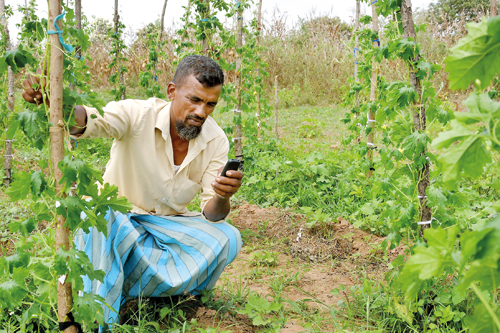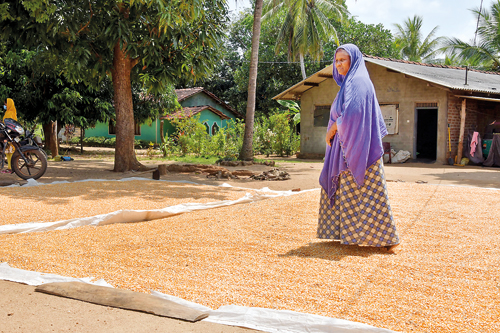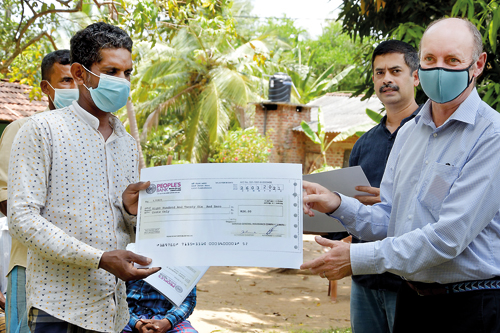Farmers get ‘bundled solutions’ to fight weather vagaries
Galenbindunuwewa was ripe with harvest. The golden paddy fields had been freshly reaped, and storks and egrets were picking about in immaculate flocks, as the occasional eagle, harrier or kite swooped down in a sharp dive for a quick meal of whirring insect or munia.

Tech support: A farmer checking the agro-climatic services sent via SMS. Pix by Samurdhi Ranasinghe/IWMI
Hidden was the fact that the guardians of these dry zone pastorality were “probably the most vulnerable people in Sri Lanka” according to Simon Langan, who is Director, Digital Innovation and also Country Manager in Sri Lanka for the International Water Management Institute (IWMI).
We were in the Anuradhapura district at the end of March for the first leg of a new initiative by IWMI to make these people, so dependent on water, less vulnerable and more productive. Perpetually at the mercy of floods or droughts, these farmers of maize and paddy lead an uncertain, precarious existence.
IWMI, though headquartered in Sri Lanka, is present in more than 30 countries in Asia and Africa, and in a number of them has already begun providing ‘bundled solutions’ for people challenged due to the lack of water.
“70% of earth’s water is used for agriculture and 750 million people in South Asia are exposed to weather and water related disasters,” says Simon.
For the farmer of maize, who relies solely on rain (and not irrigated water like paddy) a slight shower more or less than the required amount could spell disaster. They also have trouble finding quality seeds and access to agricultural advice.
IWMI’s answer, packaged with care, was christened the Bundling Insurance with Climate Information and Seeds system.
An index insurance was the “turkey on the table” in this bundle, and we were actually heading for the official ceremony when the first insurance payouts were to be handed over.
Outside T. Mihilar’s house in Dunumandalewa, the 100 farmer recipients had gathered in a tin roofed ‘tent’ with a table adorned with plastic flowers in pride of place. Each farmer was given a payout amounting to Rupees 1,000 for the excess rainfall that season.
There were speeches, and none more memorable than that of Dr. Giriraj Amarnath, who tried his homespun Tamil learnt on the field. An Indian, this is pretty much ‘his’ project- as the Research Group Leader for Water Risks and Disasters.
Giriraj explains that the insurance scheme made possible with SANASA is simple and efficient because it is satellite-based. From satellite measurements, rainfall is calculated and compensation is given if there is excess or deficit than what is required.
Giriraj says that though the farmers are vulnerable and marginalized, they spend as much as Rs. 15,000 to 18,000 on one acre alone.
“And the amount they invest is not secured- if any climate shocks come.”

Part of the process: A woman farmer drying maize in Galenbindunuwewa
“When you buy a car by default your car is insured. But what a farmer spends on fertilizer, seeds, labour costs and electricity never gets accounted. One pest disease or 20 days of no rain can wipe out a crop”
But insurance is only part of the system. Climate resilient seeds will be provided to farmers from the next season. These hybrid seeds are genetically improved, and can resist to a temperature, or excess rainfall or deficit rainfall.
“In this part of the country it is all about excess rainfall,” says Giriraj, “maize should not receive too much rain.”
The seed they bring in, Simon says, will “stay underwater for longer- just as the dry-resistant one can sit there doing nothing until the rains.”
Says Mohamed Aheeyar, researcher at IWMI, “when we were in the field crop cutting, we found about four to five seed varieties, and the farmers do not know how they have got into the field. Whatever is available in the market- they just pick it up.” These substandard seeds do not help yields.
After the payouts and speeches of thanks are over, we linger in the tent to talk to a few new beneficiaries.
Weather-beaten Mihilar (48) of Dunumandalewa who was instrumental in persuading other villagers, says that they were reluctant to subscribe at first- certain schemes having scammed them before, but soon such wariness was cast aside.
Gayani Nirmalee Bandara Menike from the village of Veheragala too recalls being very circumspect at first, but pronounces herself relieved and happy now.
She also found helpful the texting service which provided farmers with weather forecasts and agronomic advice, which is the third component in the bundle.
“On Monday and Friday we provide weather forecasts. Wednesday is for agronomic advice” explains Giriraj.
Data is provided by the Indian Meteorological Department a month in advance and the IWMI gets the help of a senior agricultural officer, Mohamed Rahju, to prepare forecasts.
“These will let you know if there would be scattered rainfall or extreme rainfall in the next ten days, and practical advice for example would let you know what pesticides you have to introduce, and how much you have to spray on that particular day.”

IWMI’s SImon Langan hands over a cheque to a farmer while Dr. Giriraj Amarnath looks on
Gayani says “for the first time we know when exactly to put fertilizer, when the droughts will come, when it’ll rain or when the skies will be good. This will enable us to take our harvest to higher levels.”
At the end of the event, we strike out across the land towards the maize cultivations, beaming in rich gold yellow through brown, paper dry leaves, against a blue sky and stenciled purple hills.
There are signs of hope everywhere in the dusky landscape. “This is just the first pilot project,” says Giriraj. “We are going to scale this in Ampara, Hambantota, Anuradhapura, Kurunegala and Vauniya.”
They will expand to green gram, black gram, chili “and then onion and beyond”. But for the moment it is about building trust.
“Initially there might be some difficulty”, they say “but slowly it’ll grow…”



